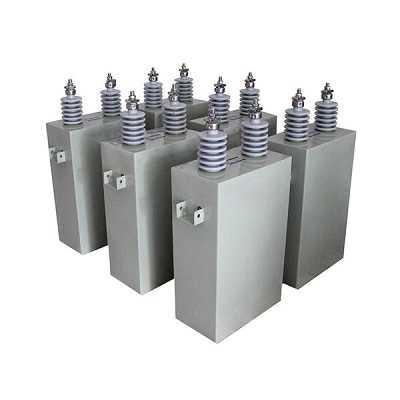Whether the operation of the power capacitor is safe and stable is closely related to the data of each parameter. Recently, some customers asked: What is a high-voltage capacitor? What is the working principle? Which is better, high-voltage capacitors or low-voltage capacitors? Today's article answers everyone!
The structure of high voltage capacitors:
A high-voltage capacitor is composed of a cylinder, the top of the cylinder, a flat cover or a hemispherical head, a sealing element, and some accessories. The outer casing is sealed and welded with thin steel plates, and the outgoing porcelain sleeve is welded on the outer casing. The connection terminal is drawn out from the outgoing porcelain casing. The capacitive element group (also known as the core) in the shell is formed by connecting several capacitive elements. The capacitive element is made of capacitor paper, film composite or pure film as the medium, and aluminum platinum as the plate.
High-voltage shunt capacitors are mainly used in AC power systems with power frequency (50Hz or 60Hz) of 1kV and above to improve power factor and power grid quality. The power capacitor manufacturer warmly reminds us that there should be no severe mechanical vibration, no harmful gas, and steam, and no conductive and explosive dust in the installation and operation place.

The working environment of high voltage capacitors:
(1) The ambient temperature of the high-voltage capacitor should not exceed 40 degrees Celsius.
(2) The ambient air humidity of the high-voltage capacitor should not exceed 80%.
(3) The altitude of the working environment should not exceed 1,000 meters, and there should be no steam, corrosive gas, dust, or fibers around.
(4) The power capacitor manufacturer warmly reminds us that the installation environment should not be inflammable, explosive, or violently shaken. The capacitor chamber of the high-voltage capacitor should have fire resistance and the fire resistance rating should not be less than Class II.

The structure of low-voltage capacitors:
The low-voltage capacitor compensation cabinet is composed of a cabinet shell, busbar, circuit breaker, isolating switch, thermal relay, contactor, lightning arrester, capacitor, reactor, primary and secondary wires, terminal block, power factor automatic compensation control device, panel instrument, etc.
The working principle of low voltage capacitors:
Power capacitor manufacturers tell you that it is based on the load current provided by the power grid to electrical equipment, which consists of two parts, active current and reactive current. The power supply capacity is greatly reduced, which reduces the power factor. It is to use the capacitive reactive current generated by the device to quickly and accurately track and offset the inductive reactive current in the grid, thereby improving the power factor, ensuring the quality of power consumption, improving the power supply capacity of power supply equipment, and reducing losses in the circuit.
What is the difference between a high-voltage capacitor and a low-voltage capacitor?
Capacitors have two key parameters: capacity and voltage. The capacity of the capacitor refers to the size of the capacitor, and the voltage refers to the voltage that the capacitor can withstand. The insulation requirements of the insulating material of high voltage capacitors are much stricter than those of low voltage capacitors.